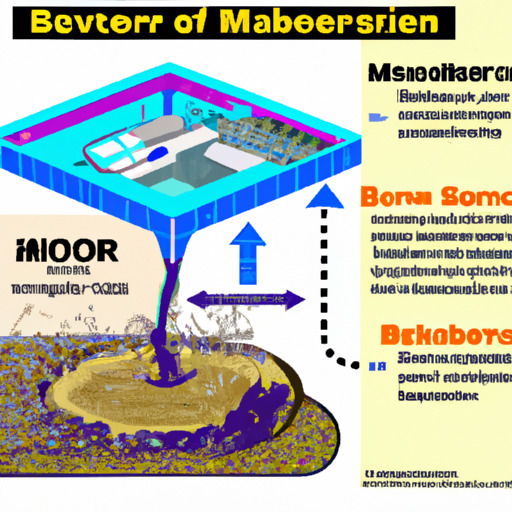Are you curious about the latest advancements in wastewater treatment technology? Look no further! In this article, we will be exploring the benefits of Moving Bed Biofilm Reactor (MBBR) technology for wastewater treatment. MBBR technology is revolutionizing the way we treat wastewater, offering improved efficiency, cost-effectiveness, and environmental sustainability. By incorporating a specially designed biofilm carrier system, MBBR technology maximizes the surface area available for microbial growth, resulting in enhanced treatment capabilities. Say goodbye to traditional wastewater treatment methods and join us on this journey to discover the exciting advantages of MBBR technology!
Overview of MBBR Technology
What is MBBR Technology?
MBBR technology is a highly effective and innovative approach to wastewater treatment. It utilizes a biological process to break down organic pollutants in water, making it safe for discharge or reuse. The technology is based on the use of small plastic carriers, known as biofilm media, which provide a surface area for microorganisms to attach and grow. These microorganisms then consume the pollutants, purifying the water.
How Does MBBR Technology Work?
MBBR technology works by creating the ideal conditions for the growth of microorganisms that can degrade organic matter. The biofilm media, made of durable and lightweight plastic, are placed in a tank or reactor. Wastewater is continuously passed through the reactor, allowing the microorganisms to attach themselves to the biofilm media. As the water flows through the reactor, the microorganisms break down and consume the organic pollutants, converting them into harmless byproducts. The treated water is then separated from the biofilm and discharged or reused.
Advantages of MBBR Technology
MBBR technology offers several advantages over conventional wastewater treatment methods. Firstly, it has a high treatment capacity, allowing for the efficient treatment of large volumes of wastewater. Secondly, it reduces the footprint and capital costs associated with wastewater treatment plants, making it a cost-effective solution. Additionally, MBBR technology enhances nutrient removal, resulting in cleaner water. Overall, MBBR technology is a reliable and effective solution for wastewater treatment.
Efficiency of MBBR Technology
Increased Treatment Capacity
One of the key benefits of MBBR technology is its ability to handle high volumes of wastewater. The biofilm media used in the process provides a large surface area for microorganism growth, allowing for efficient treatment. This increased treatment capacity is particularly beneficial for municipal wastewater treatment plants and industrial facilities that produce a significant amount of wastewater.
Reduced Footprint and Capital Costs
Compared to conventional wastewater treatment methods, MBBR technology requires a smaller physical footprint. The compact design of the reactors and the use of biofilm media allow for a more efficient use of space. This not only reduces the land required for wastewater treatment but also lowers the capital costs associated with constructing and maintaining larger treatment plants.
Enhanced Nutrient Removal
MBBR technology is highly effective in removing nutrients such as nitrogen and phosphorus from wastewater. The biofilm media provide an ideal environment for the growth of microorganisms that can consume these nutrients. By enhancing nutrient removal, MBBR technology helps to protect water bodies from pollution caused by excessive nutrients, such as algal blooms.
Flexibility and Scalability
Suitable for Various Wastewater Types
MBBR technology is versatile and can be adapted to treat a wide range of wastewater types. Whether it is domestic sewage, industrial effluent, or agricultural runoff, MBBR technology can effectively remove pollutants and produce high-quality treated water. This flexibility makes it a valuable solution for different industries and sectors.
Easy Expansion and Retrofitting
Another advantage of MBBR technology is its ability to be easily expanded or retrofitted. As the needs of a wastewater treatment plant change over time, MBBR reactors can be added or modified to accommodate increased flow rates or changing pollutant characteristics. This scalability ensures that the treatment facility remains efficient and effective, even as demands fluctuate.
Adaptable to Fluctuating Loads
Many wastewater treatment plants experience variations in wastewater flow and pollutant loadings throughout the day. MBBR technology is highly adaptable to these fluctuations and can maintain consistent treatment performance. The biofilm media provide a buffer, allowing microorganisms to continue degrading pollutants even during periods of high or low flow rates. This adaptability ensures reliable and stable treatment under varying conditions.
Improved Treatment Performance
Increased Surface Area for Biofilm Growth
The biofilm media used in the MBBR process provide a large surface area for microorganisms to attach and grow. This increased surface area allows for a higher biomass concentration, resulting in more effective pollutant removal. The microorganisms in the biofilm efficiently break down the organic matter, resulting in improved treatment performance.
Enhanced Organic and Nutrient Removal
MBBR technology has been proven to enhance the removal of organic matter and nutrients from wastewater. The microorganisms in the biofilm consume organic pollutants and convert them into harmless byproducts. Additionally, the process is highly efficient in removing nitrogen and phosphorus, which are common pollutants in wastewater. By enhancing organic and nutrient removal, MBBR technology helps to ensure the safety and cleanliness of water resources.
Reduced Sludge Production
Sludge production is a significant concern in wastewater treatment due to its disposal and management requirements. MBBR technology offers an advantage in this regard, as it produces less sludge compared to conventional treatment methods. The biofilm media allow for a higher sludge retention within the reactor, reducing the amount of sludge that needs to be processed and disposed of. This not only saves costs but also minimizes the environmental impact associated with sludge management.
Operational and Maintenance Benefits
Reduced Energy Consumption
MBBR technology is known for its energy efficiency. The process operates under aerobic conditions, requiring less energy for aeration compared to other treatment methods. The microorganisms in the biofilm are self-regulating and consume organic matter efficiently, reducing the energy needed for treatment. This results in lower energy consumption and operational costs for wastewater treatment plants.
Less Chemical Usage
In traditional wastewater treatment methods, chemicals are often used to enhance treatment performance or address specific challenges. MBBR technology reduces the dependency on chemicals, as the microorganisms in the biofilm are capable of removing organic matter and nutrients without the need for additional chemical additives. This not only reduces operational costs but also minimizes the use of potentially harmful chemicals.
Lower Odor and Noise Levels
Odor and noise pollution are common concerns in wastewater treatment facilities. MBBR technology helps to mitigate these issues, as the process operates in a closed system that prevents the release of odorous gases. Additionally, the use of biofilm media reduces the need for mechanical components such as pumps and mixers, resulting in lower noise levels. This creates a more pleasant working environment for plant operators and nearby communities.
MBBR Technology for Industrial Wastewater Treatment
Effective in Treating Industrial Pollutants
Industrial wastewater often contains complex and challenging pollutants that require specialized treatment. MBBR technology has proven to be effective in treating a wide range of industrial pollutants, including organic compounds, heavy metals, and industrial chemicals. The high biomass concentration and adaptable nature of the process make it well-suited for handling the unique characteristics of industrial wastewater.
Adaptable to Complex Industrial Processes
Industrial processes can vary significantly in terms of wastewater flow rate, composition, and variability. MBBR technology is adaptable to these complexities, allowing for efficient treatment regardless of the specific industrial process. The versatility of the biofilm media and the ability to adjust process parameters make MBBR technology an ideal choice for industrial wastewater treatment.
Resistant to Toxic Shock Loads
Industrial processes can occasionally generate toxic shock loads in wastewater, which can be harmful to the treatment process. MBBR technology has inherent robustness and resilience, allowing it to withstand and recover from such shock loads. The biofilm media provide a protective environment for the microorganisms, ensuring their survival and continued treatment performance even in the presence of toxic substances.
Integration with Other Treatment Processes
Combination with Activated Sludge Process
The integration of MBBR technology with the activated sludge process can enhance treatment efficiency and performance. By using MBBR as a pre-treatment or post-treatment step, the overall treatment capacity can be increased, and nutrient removal can be improved. The biofilm media in the MBBR process ensure a higher biomass concentration, providing a stable and efficient microbial population for the activated sludge process to enhance treatment.
Enhancement with Membrane Technology
MBBR technology can be further enhanced by integrating membrane technology into the process. Membranes can be used as a separation barrier to further purify the treated water, removing any remaining suspended solids or contaminants. This hybrid MBBR-membrane system allows for a higher level of treatment and produces water of even higher quality, suitable for specific reuse applications.
Integration with Anaerobic Treatment
MBBR technology can also be integrated into anaerobic treatment processes to enhance overall treatment performance. The anaerobic treatment stage can break down complex organic matter and produce methane gas, while the MBBR process can further remove remaining pollutants and nutrients. This combination offers a more comprehensive and efficient solution for wastewater treatment, particularly in industries that produce high-strength wastewater.
Case Studies and Success Stories
Application in Municipal Wastewater Plants
MBBR technology has been successfully applied in numerous municipal wastewater treatment plants around the world. These plants have reported improved treatment performance, increased capacity, and reduced operational costs. The MBBR process has proven to be reliable, efficient, and adaptable to varying municipal wastewater characteristics, ensuring the production of clean and safe water for communities.
Industrial Implementation and Results
In industrial settings, MBBR technology has been implemented to effectively treat complex and challenging wastewater streams. Industries such as food and beverage, pharmaceuticals, and petrochemicals have witnessed significant improvements in treatment performance and compliance with regulatory standards. The flexibility and scalability of MBBR technology have allowed industries to meet their specific wastewater treatment requirements efficiently.
Comparison with Conventional Treatment Methods
Comparative studies have shown that MBBR technology offers several advantages over conventional treatment methods. It has been found to have higher treatment capacities, better nutrient removal efficiencies, and reduced operational costs. The simplicity and reliability of the MBBR process make it an attractive alternative to conventional treatment methods, providing improved treatment outcomes and long-term cost savings.
Challenges and Limitations
Need for Skilled Operation and Maintenance
MBBR technology requires skilled operators and maintenance personnel to ensure optimal performance. Monitoring the process parameters, managing the biofilm media, and addressing any potential issues require expertise and training. Adequate resources and ongoing training programs must be provided to wastewater treatment plant staff to maximize the benefits of MBBR technology.
Potential Clogging and Biofilm Loss
While biofilm media are designed to prevent clogging, certain wastewater characteristics or operational conditions can still lead to biofilm loss or reduced performance. Regular monitoring and maintenance of the biofilm media are necessary to prevent clogging and maintain stable treatment performance. Additionally, proper pretreatment and monitoring of influent wastewater are important to minimize the risk of clogging or biofilm loss.
Cost Considerations
Although MBBR technology offers numerous benefits, it is important to consider the initial investment and operational costs. The cost of biofilm media, reactor construction, and ongoing maintenance should be evaluated in relation to the specific needs and requirements of the wastewater treatment plant. However, the long-term operational savings, improved treatment performance, and ecological benefits often outweigh the initial costs.
Conclusion
MBBR technology is a proven and efficient solution for wastewater treatment. Its ability to handle high volumes of wastewater, reduce footprint and capital costs, enhance nutrient removal, and improve treatment performance make it an attractive option for both municipal and industrial applications. With its flexibility, scalability, and integration capabilities, MBBR technology provides a reliable and sustainable approach to water purification. As technology continues to evolve, the benefits of MBBR technology are likely to increase, driving its adoption in wastewater treatment systems worldwide.



